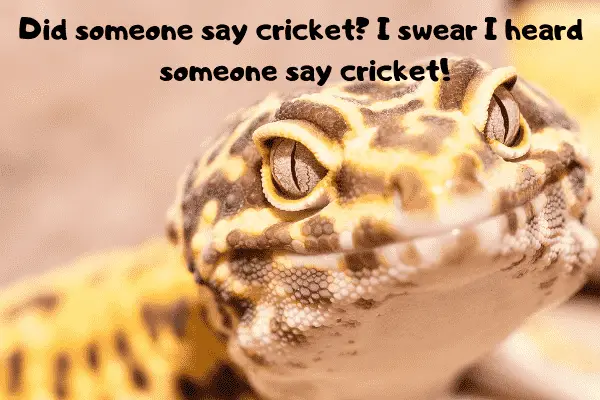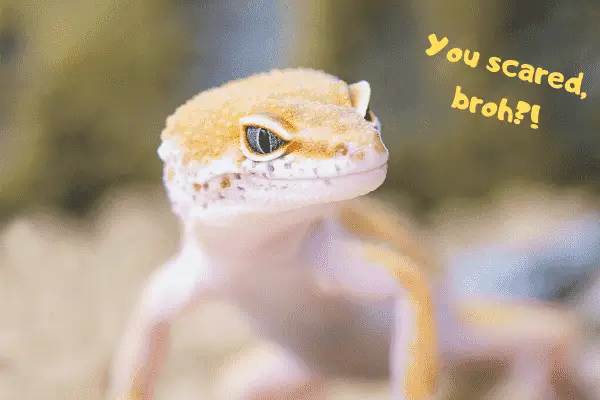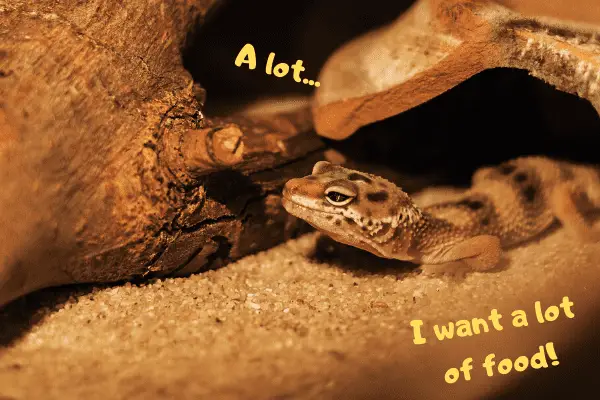Whether you’ve just bought your first leopard gecko or are double-checking just in case, this leopard gecko diet guide is going to help you get the information you need to keep their bellies full!
Leopard gecko feeding can be an as complicated or simple topic as you so choose. When it comes to leopard gecko food, there are a few common things people want to know, and they’re exactly what we’re going to cover in this post. These are…
- What to feed your leopard gecko
- How often to feed your leopard gecko
- How much to feed your leopard gecko
- What supplements does my leopard gecko need?
After covering each of these topics, I’ll add some tips at the end.
Want tips on everything to do with their care? Our leopard gecko care guide will help you on your way!

Table of Contents
What should I feed my leopard gecko?
A leopard gecko’s diet can consist of a variety of different things. First of all, a leopard gecko is an insectivore, which means it’s main food source is insects.
To keep your pet leopard gecko in optimal health, these insects should be gut loaded prior to feeding them to the gecko.
Gut loading pretty much just means giving the insects a nice large meal before you feed them to your gecko. This helps to make the meal more nutritious for your leo.
This is something that I personally didn’t know about when I got my first leopard gecko. It reached the age of three before it eventually died due to an unknown disease/illness.
That being said, I always kept crickets in a large tub with access to food. Gut loading insects before giving them to your gecko will increase its strength and is an important thing to do. After all, you are what you eat!
So, what should you be feeding your leopard gecko?
Staple leopard gecko food:
- Crickets
- Mealworms
Treats best not given too often:
- Superworms
- Waxworms
These last two shouldn’t be given to your leopard gecko all too often. They can cause your gecko to put on too much weight or become under-nourished.
Everything you feed your leopard gecko should ideally still be alive. The crickets and mealworms you give to them should be alive, as most gecko’s won’t feed on dead insects.
Trying to feed them dead insects can be very detrimental to their health. Even though some will take dead insects, you don’t know how long they’ve been dead for. Dead bodies release ammonia which is very bad to your leo’s health. Other parasites and bacteria can also be ingested when you feed them dead insects.
Note: Waxworms and super worms should only be fed to adult L
If the crickets are too large then they just won’t go for them.
A general rule of thumb:
Leopard geckos up to 5-6 months – up to 3-week old crickets
Leo’s up to 10 month – up to 4-week old crickets
Leo’s older than 10 months are considered as adults, they can eat any sized crickets really. There are a few different species of crickets that can be fed to your leopard gecko. Try to switch things up every now and again.

Scared of offering your leopard gecko live food?
No worries! If you’re not too keen on crickets bounding around your room, stick them in the fridge, or another cool place. This will slow your crickets down a lot and make them much easier to feed your leopard gecko.
Note: Crickets aren’t the most hygienic animals and some may carry forms of salmonella. Be careful where and how you place them into your fridge if you want to use this method.
The crickets are harmless, so if you don’t want to put them in the fridge then just keep in mind that your fears are irrational. ?
Learn more about gut feeding in our guide on caring for crickets!
How should I feed my leopard gecko
When it comes to feeding your leopard gecko, there’s a lot of discussion. Let’s be honest here…
In the wild, leopard geckos aren’t fed in a certain way and probably encounter a whole host of different scenarios.
That being said, your pet doesn’t live in the wild, and you have a responsibility to do your best for your leo.
A good way to feed your leopard gecko is on a feeding dish. This can be one that’s specially designed, or it can be one that you create yourself.
The feeding dish won’t have much impact on the crickets you feed your leo. What it will impact though, is the mealworms!
Depending on which substrate you use, mealworms can dig, hide and crawl around in or around it.
Especially the digging can get quite annoying… You won’t be the first to wake up with beetles in your terrarium!
You also have the option to feed your gecko using tweezers, but this isn’t really ideal. Firstly, your leopard gecko is an animal, and it should be free to hunt and explore in our opinion.
Secondly, the tweezer can bring in nasty bacteria, as well as harm your gecko as it snaps its mouth shut on top of it. If you do use tweezers for whatever reason, make sure they’re soft and won’t harm their jaws.
Another reason to use the feeding dish is that it will ensure the supplement the insects are coated in stays on for longer. Your gecko should eat the insects while the supplement is still on there to ensure they get the maximum benefit from them. More on supplements a little later on in this post!
A note on water: Make sure to provide your leopard gecko with fresh water every 2-3 days roughly (the more often, the better). The water should be provided in a shallow container. Anything that’s too high, or if they can’t see the water, they may not be able to find the water.
Also, if there’s ever any excrement or dead insects in the water, make sure it’s removed and refreshed straight away. Faeces and dead insects release ammonia into the water quickly if not cleaned.

How much should I feed my leopard gecko
Gaging how much you should feed your leopard gecko is hard to do without knowing the individual gecko. It’s best to experiment a little bit and get to know your gecko to gauge how much they should be eating.
Once your gecko is full, it will stop eating. It’s usually ok to leave the crickets in there till your leo gets hungry again, but make sure to keep an eye on them.
Some species of crickets can start biting and pestering your leopard gecko. In some cases, if there are a lot of them left in, this can cause some nasty scenarios to happen.
Try to get to know your geckos feeding habits and adjust as suitable. Also, monitor their weight and do a visual inspection once in a while to ensure they’re not too fat or skinny.
How often should I feed my leopard gecko?
You should feed your gecko around 2-4 times per week. When they are younger, they should be fed about 4 times per week, as they get older this number can decrease to 2 or 3 times per week.
How often you should feed your gecko is also slightly dependant on how much you feed them as well as your gecko’s weight and feeding habits.
Leopard geckos have the possibility to store a lot of fat in their tails, so it’s not the end of the world if you feed them a day later. Just keep an eye on your reptile, as well as the size of its tail.
Again, getting into the habit of weighing your gecko from time to time is a good thing to do.
What supplements does my leopard gecko need?
Luckily for you, when it comes to supplements, leopard geckos aren’t too fussy!
The main mineral that leopard geckos need is calcium. There are many supplement mixes you can buy from pet stores or online, most containing a mix of vitamins and minerals that ensure a healthy leo.
You can coat your insects in the supplement by adding the insects as well as some powder to a separate container. After giving it a gentle shake, the insects should be dusted properly.
It’s also a good option to add a small, shallow dish to the terrarium that has the supplement in it. Leopard geckos will know when they need to fill up on calcium and other minerals. They’ll leave it alone when they don’t.
If you do go with this second option, make sure the supplement is cleaned every so often. Also, keep an eye on your leo to see if he is licking it up from time to time.
Even if they do eat it from time to time, it’s probably best to coat the insects you give them regularly too to ensure they’re getting all they need.
Leopard gecko food and diet tips
- If your leopard gecko isn’t eating regularly, then there are a few things that could be going on. Make sure to check our leopard gecko care guide, as if you don’t have the heating set up right, this may be the cause.
Other causes could be disease or just a distaste for certain foods.
To summarize…
As you can see, leopard gecko feeding doesn’t have to be complicated. We hope that you are now in a better position to care for your leopard gecko. Good luck and enjoy the time with your Leo!

